Does playing golf during the baseball season hurt your baseball swing? The answer to this question might differ slightly depending on the audience being discussed. For the sake of this explanation, we’ll separate the professional player from the amateur / youth baseball player.
A recent article by Coach McCreary on the website www.baseballbytheyard.com compared the golf swing and baseball swing and concluded that playing golf during the baseball season might negatively impact a player’s success at the plate. Coach McCreary isn’t the first baseball coach / instructor to express this opinion and in reading his analysis of both swings, I believe I understand how he is reaching his conclusion.
However I believe Coach McCreary, and the many others who share his opinion, are missing some very key elements of both actions that lead me to share a different opinion; especially for youth athletes.
The single biggest difference between the golf swing and baseball swing is the SWING PLANE. In baseball the target is approaching at varying heights (hopefully within the strike zone). Whereas in golf, the ball is resting in a still position on the ground.
The images shared below are coming directly from an article on www.baseballbytheyard.com.
Let’s compare frame #2 (image 2) of the golf swing with frame #2 (image 2) of the baseball swing. You’ll notice the connectivity between the right elbow and torso mirror each other, along with the lengthening of the left arm across the chest. In neither sport do you want to see a perfectly straight left arm (arm bar) as that will only lead to tension and limit the connection between the arm and the body.
In frame #3 of both the golf swing and baseball swing you’ll see both athletes maintaining connection between their right arm (elbow to arm pit) and their body. This helps to create an inside path to the ball for the golfer and keeps the hands inside the baseball for the hitter.
Both athletes are making contact with the ball in front of their body, keeping the head still through impact. In baseball the head may move back during the load phase of the swing, but once the front foot hits the ground, good hitters will keep their head in a still position. Similarly, golfers may slide their head back a bit during the backswing (load), but once they transition into their downswing you will see very little movement forward with the head.
In both golf and baseball, the athletes will hit against a slightly bent front leg and then lengthen (straighten) the leg to maintain balance through their finish. Tiger Woods was best known for this straightening of the leg at impact as he pushed up through the ground to maximize power. Great hitters use the ground in a similar manner, creating power from the bottom up (lower body into the upper body).
At impact, notice how both athletes have transitioned their weight from the right side to the left side. Neither the golfer or hitter has much weight resting in their right foot (frame #4 of the baseball swing and frame #3 of the golf swing). You’ll notice how the head is directly over the right knee in the baseball swing and maintains a similar position (relationship) in the golf swing. This head to knee relationship is necessary in both moves to maintain balance while releasing the torque created from the load / backswing.
The points made by Coach McCreary are consistent with many others I’ve seen and heard over the years, so let me address each one directly.
Hand Path – The hand path will be different in the golf swing and baseball swing as a result of the swings being on different planes. What’s important to understand is the connectivity between the hands / arms and body in both swings and less about the hand path. If you toss a golf ball in the air and ask a golfer to hit it, you’ll see a hand path very similar to a baseball swing. It’s all about Swing Plane.
Golfers who are more accurate will actually have the club head square to the golf ball longer during the swing than golfers who are more prone to be long ball hitters. This dynamic is seen in baseball as well as some hitters are able to plane their swing better, keeping the barrel of the bat in the hitting area longer. Hitters that are able to plane their swings, keeping the barrel in the hitting area longer are those that hit for high average.
The Feet are set differently in baseball and golf – This is merely a matter of the golfer needing to be more accurate than the baseball hitter. Watch any long drive contest and you’ll see golfers with extremely wide bases (feet) for the purpose of wanting to maximize torque and weight transfer. Unfortunately, in the sport of golf, golfers have to play their foul balls. As a result, golfers are rarely swinging at 100% in favor of positioning their golf ball in the fairway.
What’s important to understand is how the feet work and how both actions require the athletes to use the ground to create power from the bottom up in their swings.
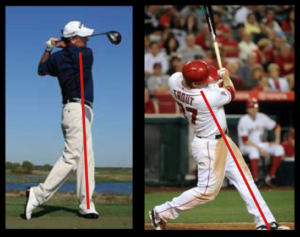 The Finish is different in golf – Again, the positioning of the athlete at finish is merely a result of the different swing planes. The golfer, by virtue of a more vertical swing plane, will finish balanced in a more vertical position.
The Finish is different in golf – Again, the positioning of the athlete at finish is merely a result of the different swing planes. The golfer, by virtue of a more vertical swing plane, will finish balanced in a more vertical position.
In both swings, the athletes have maintained balance throughout the swing, stayed behind the ball at impact while separating their upper and lower bodies to create maximum torque and power.
If done correctly, both athletes will have their right arms swinging across their body (on plane) with their torso pointing at their desired target.
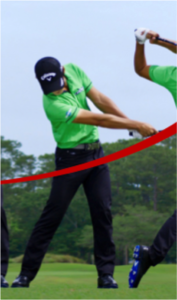 If you refer to frame #4 of the golf swing and frame #4 of the baseball swing, you’ll see both athletes in the “Power V” position with extension of both arms along with their bat / golf club.
If you refer to frame #4 of the golf swing and frame #4 of the baseball swing, you’ll see both athletes in the “Power V” position with extension of both arms along with their bat / golf club. 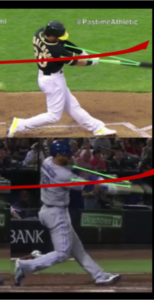
Both actions involve rotational and linear movement, requiring the athlete to sequence the movement properly to maximize power and accuracy.
The biggest difference in the golf swing and baseball swing doesn’t involve the motions and movement of the athlete, but quite simply the challenge of hitting a moving target. The timing of the baseball swing varies, based on pitch speed / location, whereas the golfer doesn’t have to concern himself with recognizing a specific pitch (fast ball vs. curve ball) or pitch location.
Morale of the story – keep playing all the golf you want and keep hitting as many baseballs as you want……and mastering the fundamentals of an athletic movement through the ball (baseball or golf).

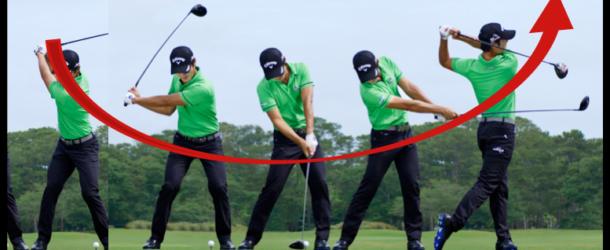
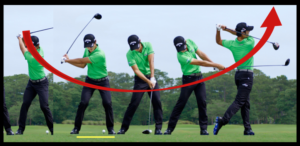
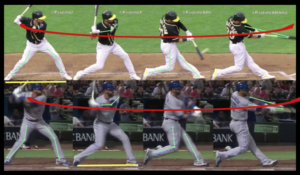









Comments are closed.